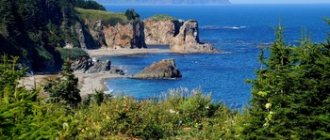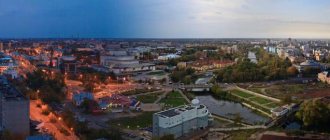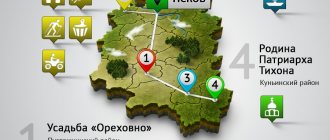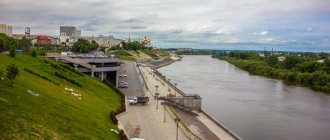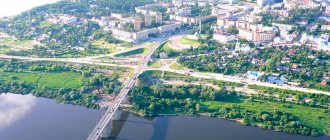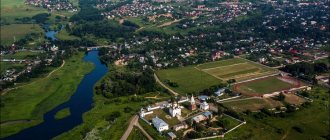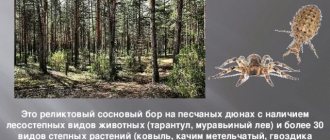The Ivanovo region is firmly associated with light industry. And this is justified: in the region they make fabrics, produce blankets and pillows, and create lacquer miniatures. In addition, the leading branch of agriculture in the region is dairy and meat livestock farming.
But the industrial center of the country is also an artistic one. The cities and villages of the Ivanovo region are included in the Golden Ring of Russia: more than 400 architectural and historical monuments from different eras have been preserved here.
For ease of route planning, we have marked all mentioned cities and attractions on the map of the region:
Cities and villages
Ivanovo
The settlement was first mentioned in 1561. In the 17th century, craftsmen in painting on fabric appeared; in the 19th century, Ivanovo manufactories became known throughout the world.
In 1871, when the two villages merged and acquired city status, there were 48 factories in Ivanovo. In 1905, workers actively supported the revolution. The country's first Council of Workers' Deputies appeared in the city, the building of which became a little dilapidated, but survived into the 21st century.
The revolutionaries, in an attempt to eradicate the religiosity of the townspeople, deprived Ivanovo of some historical monuments. There are also many sights left untouched by wars and changes in political regimes:
- Shchudrovskaya tent - a stone official hut of the 17th century;
- buildings of textile factories of the 18th century;
- the “Ship” and “Horseshoe” houses, the circus building and the Medical Academy in the Stalinist Empire style;
- The Church of the Assumption of the Blessed Virgin Mary is the only one that has survived from the 17th century;
- The Holy Vvedensky Convent, built only at the end of the 20th century.
On the streets of the city there are houses of ordinary citizens built in the 17th-20th centuries. The Museum of Industry and Arts presents a complete collection of exhibits dedicated to the history of the Ivanovo region. The museum is considered the best in Russia in terms of the value of its collections.
More about interesting places in Ivanovo in this material.
Plyos
The first settlement on the site of the city was formed in the 12th century. Thanks to its favorable location on the Volga, by the end of the 18th century Plyos had turned into a shopping center. Then the city's artisans became famous throughout the country for their silk and woolen products and jewelry.
In the 19th century, the railway appeared in Russia, but not in Plyos. Trade in the city died down, the craftsmen left. The calm town attracted the attention of the capital's bourgeoisie. Isaac Levitan painted more than 200 paintings here. Fyodor Chaliapin, Ilya Repin, and Alexey Savrasov vacationed at their own dachas in Ples.
The main attractions of Plyos:
- Church of the Life-Giving Trinity in Baroque style;
- Church of the Resurrection, immortalized by Levitan in the painting “Above Eternal Peace”;
- the building of the Public Offices, preserved from the 18th century;
- museum, recreating the atmosphere of past centuries;
- the house-museum of I. I. Levitan, where the artist himself lived, dedicated to the works of the famous landscape painter.
Interesting and useful information about Plyos and its attractions.
Shuya
The first mention of the settlement dates back to the 14th century. The name of the city is associated with the famous family, whose representative, Vasily Shuisky, ascended the throne in the Time of Troubles.
From the moment of its foundation, the city was loved by the reigning persons. Ivan the Terrible made Shuya his property.
According to legend, in the 18th century, the icon of the Shuya-Smolensk Mother of God cured Peter I of cholera.
Konstantin Balmont was born in the city: the local history museum is named after the poet. Mikhail Vasilyevich Frunze worked in Shuya. In honor of the revolutionary, a memorial museum dedicated to the life of the military leader and the history of the city was opened.
Shuya has never competed with the regional center in folk crafts. Local attractions are represented mainly by temples and museums:
- Resurrection Cathedral with a bell tower, the like of which does not exist in the world: the belfry, 106 meters high, stands separately from the temple;
- Church of the Intercession, the architect of which is considered to be the Italian Maricelli;
- Literary and Local Lore Museum named after. K. Balmont, where over 4,000 exhibits dedicated to the poet are stored;
- museum “State Wine Warehouse No. 3” with the opportunity to try the products;
- soap museum: in the 17th century, Shuya was famous for its soap factories throughout the country.
More about everything interesting in Shuya - here.
Kineshma
The settlement was founded in the 15th century. The city is located on the banks of the Volga, which is why it has become a major industrial center of the region - second only to Ivanovo.
Religious and civil buildings of the 17th-19th centuries are well preserved in Kineshma. On the streets of the city there are stone mansions and wooden houses with carved frames.
The future commissioner Dmitry Furmanov studied at the Kineshma school. The educational institution with the memorial plaque remains intact in the 21st century.
The history of the city is most closely connected with Alexander Nikolaevich Ostrovsky. The playwright worked as a magistrate in Kineshma. The writer created his plays, borrowing prototypes of heroes from his contemporaries living in the city. After Ostrovsky's death - in 1897 - a theater named after him was opened. Thanks to the influx of lovers of Alexander Nikolaevich’s work, a strong pier appeared in the city.
Main attractions of Kineshma:
- the ensemble of the Assumption and Trinity Cathedrals with a five-tier bell tower;
- Drama Theater named after A. N. Ostrovsky, in the building of which the theater museum is located;
- Red shopping arcades, built in three styles at once: classicism, eclecticism and modernism;
- an art and historical museum dedicated to the history of the city;
- museum of felt boots with pairs of the smallest and largest shoes included in the Russian Book of Records.
What is important to know when going to Kineshma?
Dunilovo
The village, founded in the 14th century, was named Dubnilovo: craftsmen who tanned leather lived and worked here. Over time, one letter dropped out of the name.
Peter I gave Dunilovo to his father-in-law. Fyodor Lopukhin, to emphasize the significance of the settlement, immediately erected the first stone church. In the village, located at the intersection of trade routes, there were many merchants, and almost each of them considered it their duty to build a new temple in Dunilovo.
After perestroika, the village was deserted. Businesses closed and residents moved away. But in quiet Dunilovo, pilgrims and tourists are regular guests. The city's attractions are represented by religious buildings of varying degrees of preservation:
- Assumption Convent, where, according to legend, Peter I forcibly sent his unloved wife Evdokia;
- St. Nicholas Chapel of the 19th century, classically built;
- Church of the Exaltation of the Holy Cross made of red brick;
- The ensemble of the Churches of the Intercession of the Blessed Virgin Mary and All Saints is dilapidated, but the paintings inside are well preserved;
- current Transfiguration Church.
Palekh - a center of folk art
Palekh greeted us with sunshine. This is one of the centers of Russian folk crafts. They mainly paint papier-mâché boxes here, so Palekh can be called a competitor to Fedoskino near Moscow.
Traveling around the Ivanovo region: Semigorye, Yuryevets, Kineshma, Ples, Palekh photo 6
Palekh is a popular tourist destination. Looks clean and well maintained. There are many different museums and more than one souvenir shop. You can spend a whole day in this place, or better yet two, to have time to explore everything. Our program included visiting three museums in 1.5 - 2 hours.
Traveling around the Ivanovo region: Semigorye, Yuryevets, Kineshma, Ples, Palekh photo 7
The guide clearly loves her Small Motherland, local crafts and master artists, so she tried to give us an unreal amount of information. Many people's heads were spinning and few people listened to the last third of the excursion. In addition, we were not given time for souvenirs and some left the museum for the shop located opposite.
The Museum of Palekh Art, which was number “3” in our program, turned out to be crumpled. In addition to all of the above, the group was urged on by the caretakers. It’s just that we arrived at the end of the working day and didn’t have time to complete the excursion before closing, but they really wanted to go home.
Traveling around the Ivanovo region: Semigorye, Yuryevets, Kineshma, Ples, Palekh photo 8
Traveling around the Ivanovo region: Semigorye, Yuryevets, Kineshma, Ples, Palekh photo 9
While we were indoors, a thunderstorm broke out outside the window, but according to the program there was still one more object to explore - the Church of the Exaltation of the Cross. It survived the Soviet era, since it was declared a museum, as it was painted by Palekh masters. Yes, it turns out that pre-revolutionary Palekh is the center of icon painting, and not lacquer miniatures. It was necessary to retrain for painting boxes after 1917.
Traveling around the Ivanovo region: Semigorye, Yuryevets, Kineshma, Ples, Palekh photo 10
Unfortunately, the temple was closed. Not everyone decided to get off the bus in a thunderstorm, but our group, who didn’t know that we wouldn’t be able to get to church, decided to go out in the downpour and got a little wet. Umbrellas didn't help. In such a damp state and under heavy rain, we went to the Semigorye rest house.
You can read more about the sights of the village of Palekh here>>
Natural attractions of the Ivanovo region
Cathedral Mountain (Ples)
Address: beginning of the street. Kornilov GPS coordinates: 57.459055, 41.515588
On Cathedral Hill, only an earthen rampart remains from the fortress built in the 15th century. The place was never built up with townspeople's houses. The mountain is surrounded by an alley with birch trees that remember Prince Vasily Donskoy, the founder of the city.
On the mountain is the Assumption Cathedral and the preserved buildings of the Government Places. Since the beginning of the 20th century, Cathedral Mountain has served as a reminder of Prince Donskoy - a monument to the founder of Plyos was erected here.
Asaph Islands
Address: Ivanovo region, Yuryevets GPS coordinates: 57.289778, 43.159139
The Asafov Islands were formed on the site of the mountains of the same name in the middle of the 20th century. In the 1950s, the water level in the Volga rose sharply, and the wave flooded part of the city. The mountains went under water along with nearby villages. The remains of the peaks have become an archipelago of nine islands with six separate lakes.
Tradition says that in the mountains there was a refuge for the robber Asaph and his accomplices. For centuries, attempts have been made to find the treasure hidden by the gang. So far - to no avail.
In the 21st century, the islands, covered with white sand, have turned into city beaches and a favorite place for fishermen.
Rubskoye Lake
Address: Ivanovo region, Teykovsky district GPS coordinates: 56.725833, 40.614167
The reservoir, located 35 km from Suzdal, is 3 times higher in mineralization than Lake Baikal. Local residents claim that swimming here cures psoriasis and eczema.
The age of Lake Rubskoye is estimated at millions of years. The place is carefully protected: the forests here are almost untouched, and mushrooms, cranberries and lingonberries are abundant every year. The deepest parts of the lake reach 17 meters.
It is safe to swim in shallow water even with children.
Holy Lake
Address: Ivanovo region, Yuzhsky district GPS coordinates: 56.607674, 42.356581
According to the version familiar to every local resident, the lake arose on the site of a well, which was used by Elder Philaret, who lived here in solitude.
Researchers have calculated that the water reserve in the Holy Lake is 7 million cubic meters.
There are a lot of vacationers on the reservoir in summer: the coastal zone is covered with sand, the water warms up well, and the place is protected from the winds by trees. Mushrooms and plants listed in the Red Book grow in the forests. Rare protected insects are also found here: swallowtail, willow moth, peacock's eye.
Alekseevskoye Estate (Nogino)
The Alekseevskoye estate is a unique and beautiful place in the Ivanovo region, which is a miniature copy of the Peterhof palace and park complex. Created this ensemble in the 1780s. in his Nogino estate Alexey Koptev, retired second major of the Preobrazhensky Guards Regiment.
In the old estate, Koptev ordered the ravine to be blocked with a dam, which led to the formation of a pond; on its other bank he began construction. Koptev named the new manor house and the area around it Alekseevskoye in his honor. Peterhof became the prototype for the layout of the estate, although this correspondence is very conditional - only its individual elements were used.
Around the estate house there is a beautiful park of linden, birch, spruce, fir, acacia and siren, decorated with ponds. A house church was erected in a beautiful place in the park, and a chapel was built on an artificial island in the pond, which was accessible only by boat. Other outbuildings, except for 2 servants' wings, were moved outside the estate.
Historical and entertainment places of the Ivanovo region
Farm "Shartom Ostrich"
Address: Shuisky district, near the village of Vvedenye Telephone: Website: https://ivstraus.ru/ Opening hours: 12.00-14.00 Sat-Sun and holidays, Mon-Fri - weekends Cost: 150 rubles How to get there: left turn in front of the village of Vvedenye , behind a rural gas station
The name of the place is associated with the nearby Nikolo-Shartomsky monastery. The farm contains 15 low-maintenance birds: emu and African.
Tours last 40 minutes. Visitors are allowed to touch, feed and photograph the ostriches. The farm sells bird eggs and ostrich fat.
Art Gallery named after. D. A. Trubnikova (Furmanov)
Address: Furmanov, st. Sovetskaya, 9 Phone: Website: https://fkgalerea.ucoz.com/ Opening hours: 09.00-17.00 Mon, Wed-Sun; Tue - closed Cost: 100 rubles
The gallery is located in a 19th-century building: the wealthy city manufacturer Gorbunov gave the house to his daughter for her wedding. At the end of the 20th century, a gallery dedicated to the Russian artist Dmitry Alekseevich Trubnikov was opened here. The painter spent most of his life in Furmanovo.
The main exhibition consists of works by the famous artist and his students: A. P. Basov, K. M. Maksimov, I. I. Kauzov. The gallery also presents exhibits related to the history of the Furmanov region and the development of the textile industry here. Most collections include household items from peasants who lived on the territory of Furmanov in the 19th century.
House-Museum named after D. A. Furmanov (Furmanov)
Address: Furmanov, st. Bolshaya Furmanovskaya, 69 Phone: Website: https://www.museum.ru/M526 Opening hours: 11.00-17.00 Tue-Sun, Mon - closed Cost: 50 rubles
The museum dedicated to the writer opened in 1958, and was closed in 1995, after perestroika. After 10 years, the house-museum started working again. But the emphasis of the exhibitions was shifted from the activities of the writer and revolutionary to the history of the region.
The first room contains original photographs and documents telling about the development of Furman factories. The second one presents an exhibition related to the 1905 revolution. The third room is dedicated to Dmitry Andreevich Furmanov: here are his paintings and works of art, translated into different languages.
Where to stay
If you decide to stay in Ivanovo to travel around the surrounding area and explore the city, then you need to decide what is more convenient for you: living in the center or near the bus station. If you travel around the region a lot, then the proximity of the bus station will be beneficial, and you can go to the center for half a day and not worry anymore.
If you want to combine business with pleasure, then you need to settle in the center. For example, the Onegin Hotel is located near the Uvod River and not far from that very picturesque view, in a 19th-century mansion, the rating is 8.5. Details here .
Or the four-star spa hotel Russian Manchester (that’s what Ivanovo is called, by the way) is located near the Shchudrovskaya tent, the rating is very good - 9.1. Look here
The three-star Soyuz Hotel also has a good rating - 8.9 and is located on the embankment, more details . All hotels on the map of Ivanovo:
Churches, cathedrals and temples
Temple of the Icon of the Mother of God Joy of All Who Sorrow (Furmanov)
Address: Furmanov, st. Socialist, 36 Phone: Website: https://krasnaya.cerkov.ru/ Opening hours: 08.00-17.00 Mon-Sun Cost: free
The temple was built by merchant Ivan Ivanovich Skvortsov on the outskirts of Sereda (former name Furmanov) in 1886. In 1894, the daughter of the church founder, who tragically lost her son, decided to expand the small building. The temple turned into a large cathedral by 1904.
The building is designed in the style of ancient Russian architecture. The walls of the temple were painted by the famous artist Safonov together with his students.
Under Stalin, the cathedral was closed. In 1979, a city dweller, Claudia Nikolaevna Lodygina, began to fight for the return of the temple to believers. The persistent woman’s journey through the authorities took almost 10 years. The church reopened in 1988: Claudia Nikolaevna headed the church council.
Bell tower in Lezhnevo
Address: Lezhnevo, st. Oktyabrskaya, 4
The bell tower took 7 years to build; the belfry was completed in 1823. Architect Maricelli began work on the project and was completed by local architect Pavel Voronin. The bell tower, 76 meters high, is depicted on the coat of arms of the Lezhnevsky district.
In the 21st century, the upper tiers of the structure are overgrown with grass, but the clock with chimes, built into the bell tower in 1870, continues to run.
Nikolsky Convent (Privolzhsk)
Address: Privolzhsk, 2nd Ovrazhny lane, 1a Phone: 8 (49339) 3-20-99 Website: https://monpriv.blogspot.com/ Opening hours: 08.00-17.00 Mon-Sun Cost: free
The convent in Privolzhsk was approved in 1998. In the center of the building is the Cathedral of St. Nicholas the Wonderworker, founded in the 14th century. The monastery has organized a shelter and school for girls who have lost their relatives or were removed from dysfunctional families.
Shrines of the Nikolsky Convent:
- icon of the Mother of God “of Many Names”;
- particles of the relics of St. Macarius of Unzhensk;
- Tikhvin Icon of the Mother of God.
Red Church in Vichuga
Address: Vichuga, 2nd Library St., 12 Phone: 8 (49354) 2-57-77 Website: https://sobory.ru/article/?object=01503 Opening hours: 08.00-16.00 Mon-Sun Cost: for free
The brick church in neo-Russian style was founded by the wealthy manufacturer Kokorin in memory of his deceased daughter. There is not a single column inside the building, and the walls are completely painted by the artist Safonov and his apprentices. The façade of the church is decorated with majolica panels, which have no analogues in the world.
The temple was closed in 1930. In 1989, the restoration of the church began, returning to the believers.
Old Resurrection Church in the village of Bonyachki
Address: Vichuga, st. Parkovaya, 5 Phone: 8 (49354) 25-388 Website: https://vichuga-voskr.cerkov.ru/ Opening hours: 08.00-17.00 Cost: free
The stone building in the Russian-Byzantine style was founded by the merchant I. A. Konovalov in 1904. A three-tier bell tower is attached to the church.
The temple was closed in 1936. The interior was looted and destroyed. The Old Resurrection Church was re-consecrated and opened in 1992.
Church of the Exaltation of the Cross in Palekh
Address: Palekh, st. Lenina, 16 Phone: Website: https://xn—-7sbbblo1beyl3e.xn--p1ai/ Opening hours: 08.00-16.00 Cost: free
Master Egor Dubov built the church in 1764, as evidenced by the creator’s autograph on the western side of the building. The spacious temple is painted in a mixed style.
For unknown reasons, the communists did not touch the religious building. The interior decoration has been completely preserved:
- chandelier;
- main iconostasis;
- choirs, candlesticks, lamps;
- embroidered banners;
- side iconostases.
In addition to this church, there is something else to see in Palekh - this is a village famous for its lacquer miniatures and numerous house museums.
Nikolo-Tikhonov Monastery in the village of Timiryazevo
Address: s. Timiryazevo Phone: 8 (49344) 2-21-87 Website: https://tihonov-mon.blogspot.com/ Opening hours: 09.00-17.00 Cost: free
The monastery appeared thanks to the Monk Tikhon, who built a cell in the village. Gradually, a monastery of believers was formed in this place. The Nikolo-Tikhonov monastery was built in 1498.
Under the communists, the monastery was closed. The decoration was completely destroyed, even the bell tower was broken. In 1991, the paint on the building fell off, and the image of Sergius of Radonezh appeared on the wall. Then it was decided to restore the monastery: in 1995 the monastery opened again. The miraculous icon of St. Tikhon has been preserved in the building.
If you have not yet chosen where you will live and want to save money when booking, we recommend using the RoomGuru service. Firstly, it contains hotels, apartments and guest houses from many different booking systems, so you won’t miss out on a worthwhile option. Secondly, you can immediately compare prices for one place in different services and book where it is cheaper (this is not always Booking!).
How to get there
Moscow — Ivanovo
The fastest way to get from Moscow to Ivanovo is by train: 3.5 hours. Schedule here .
It takes 5.5 hours to travel by bus from Moscow to Ivanovo. Bus schedule here
Since Ivanovo is located between Suzdal and Kostroma and is an intermediate point on the route of the classic Golden Ring, there is a bus service between these cities.
Vladimir - Ivanovo
By bus from Vladimir you can get to Ivanovo in an hour and a half. Schedule here
Suzdal — Ivanovo
You can leave Suzdal every hour; the bus will take about an hour. Schedule here .
Kostroma — Ivanovo
Buses from Ivanovo also go to Kostroma quite often. Travel time is 2.5 hours. Bus schedule
Ples - Ivanovo
Buses run frequently and travel time is approximately 2 hours. Bus schedule
Vologda — Ivanovo
Travel time from Vologda to Ivanovo by bus is almost 5 hours. Schedule

